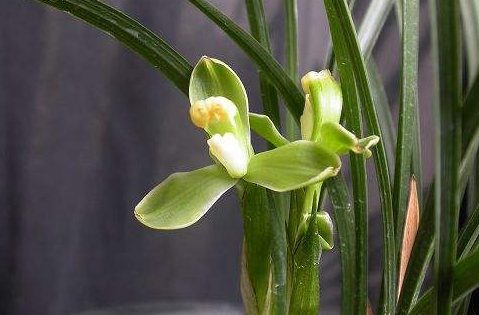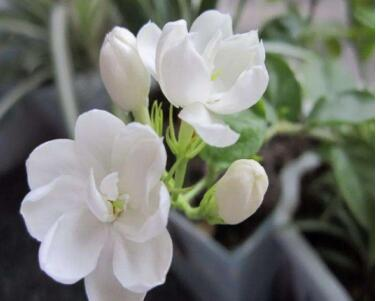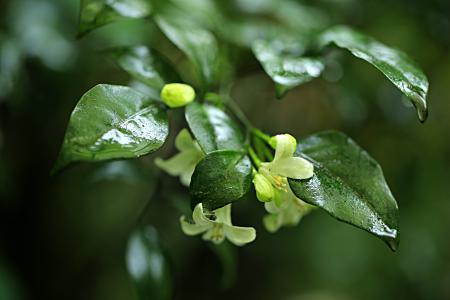How can orchids blossom?
1. Light
Although orchids like semi-overcast environment, light is an important factor in flowering, and suitable light can make plants blossom better. If you put it in a bright place before flowering, it will make the color brighter. You should have 2-3 hours of light every day, so that the flowers will be more elegant and noble.
two。 Watering
Proper watering will also promote plant flowering, to keep the soil moist, do not water more, otherwise there will be rotten roots, but too lack, there will be a clamping condition. The amount of water should be reduced in the stage of leaf bud extraction.

3. Rainproof
Orchids are afraid of waterlogging, especially for rain, which can easily lead to plant death, so avoid rain in time in rainy season and sprinkle some plant ash to adjust humidity.
4. Temperature
Orchids prefer warmth, the suitable temperature for growth is 15-25 ℃, and the best temperature difference between day and night is about 10 degrees. If it is kept at a low temperature for a long time, it will make the leaves grow small spots and stop growing.
How can orchids blossom
Orchid is one of the top ten famous flowers in China, which is deeply loved by flower friends. But if you grow orchids at home, how can you raise them well? Let me give you a specific introduction. It is the experience of the ancients to cultivate orchids with three-part planting and seven-point cultivation. Maintenance is related to whether orchids are luxuriant and blooming, so it is reasonable for predecessors to attach great importance to this. The methods of conservation and management of orchids are described in detail below. 1. The place where the orchid is placed is very important, which directly affects the growth and development of the orchid. Orchids are generally placed in the open field in spring, summer and autumn, shaded in the open field in summer and indoors in winter. It is best to be open and moist outside. There should be plenty of light in the room, preferably facing south. In this way, it is beneficial for orchids to grow. The orchid basin had better be put on the wooden frame or table, not on the ground. 2. Shaded orchids are mostly semi-negative plants, and most species are afraid of direct sunlight and need proper shade. Orchids can shine more sunshine to promote their growth in the first and middle of April. It should be properly shaded after late April. The varieties of erect leaves in Xialan and Qiulan had better be placed in the south of the shade so that they are properly exposed to more sunlight, while those with vertical leaves are better exposed to two hours of light every day. From June to September, you should cover the shade early every day. If you use Reed curtains, you can use dense curtains or two thin curtains. After October, the weather turns cool and the sun is weak, which can postpone shading, but we still need to pay attention to shading around noon. 3. Rainproof orchids can be caught in light rain, but to avoid mildew, showers or continuous rain. In the mildew and rainy season, especially to do a good job of rain prevention. From late June to mid-September, there are frequent showers. If it rains for a short time and the rainfall is small, it should be watered more in the evening to discharge the hot air in the basin, otherwise the orchid will be damaged or even withered. If the sun comes out again after the shower, it should be shaded in time to avoid the rising heat on the ground affecting the growth of orchids. Rain Water's season coincides with the stage when orchids sprout leaf buds. If the pot soil is too warm, it will cause poor leaf bud growth or lead to diseases. At this time, you can sprinkle a small amount of plant ash to adjust the humidity of the basin soil. 4. Watering the flower proverb says: dry orchid and wet chrysanthemum, this has a certain degree of truth. Generally speaking, it is best for orchids to be eight minutes dry and two parts wet. If it is too wet, it is easy to make the flowers rot and die. The principle of watering should be: dry, wet, stop, properly dry. When mastering specifically, it should be paid attention to: in the growing period, more watering should be given at the end of May-June, less watering should be done in the budding period of about 3-4 months and flowering period in about 3-4 months, and less watering or no watering should be done in the dormant period in winter. Those with large flowerpots and small orchid plants should be watered less, and those with small pots should be watered more. Hot and dry climate should be properly watered, cool and humid, such as mildew and rainy season. There should be little or no watering. For orchids newly dug from the mountains, if there are few or more broken roots, they should be watered less to dry the pot soil, so that the roots will not rot and it is conducive to the emergence of new leaves. Second, how to raise orchids in potted plants like to be clean. Not resistant to dirt, the growth is particularly exuberant in the semi-shade where it is warm and humid and sunny to the south. Potted orchids should pay more attention to the following points: pot soil selection, watering, temperature and light, fertilization, ramet and pest control. 1. Potted soil requirements of orchids: black mountain mud, peat soil, pastoral soil, pine soil, moss fresh, fern root, bark and so on can be used to grow orchids. The bottom of the basin is covered with tiles, then covered with a layer of broken brick and stone, with a thickness of 1/4 of the depth of the basin to enhance air permeability and drainage, and then spread a layer of culture soil. Plant the orchid, fill the culture soil, and cover the bulb. The soil should be compacted, and the soil should not be filled 2 cm away from Yikou, which is convenient for watering. After planting, pour enough water and place it in a cool shade. Half a month later, it was moved to a sunny and ventilated environment. In order to increase beauty and moisturizing power, the basin can be covered with a layer of small broken white stone. If the temperature is unstable in spring, it is easy to get cold when you leave the house early. It is safer to check out in early April. Summer should be placed in the shade to avoid direct sunlight and take scattered light to nurture. Autumn is the orchid sprouting period, to maintain the corresponding humidity, avoid drying, orchid root is fleshy, dormant in winter does not need much water, basin soil is wet, do not water too much, so as not to sprout root and leaf diseases. How to water orchids: flower proverb says: dry orchid wet chrysanthemum, this has a certain degree of truth. Generally speaking, it is best for orchids to be eight minutes dry and two parts wet. If it is too wet, it is easy to make the flowers rot and die. The principle of watering should be: dry, wet, stop, properly dry. When mastering specifically, it should be paid attention to: in the growing period from May to the end of June, more watering should be appropriate, the budding period of leaves should be about March to April, the flowering period should be about March to April, and the dormant period should be less watering or no watering. Those with large flowerpots and small orchid plants should be watered less, and those with small pots should be watered more. Hot and dry climate should be properly watered, cool and humid, such as mildew and rainy season. There should be little or no watering. For orchids newly dug from the mountains, if there are few or more broken roots, they should be watered less to dry the pot soil, so that the roots will not rot and it is conducive to the emergence of new leaves. How to fertilize orchids: fertilizer should not be concentrated: in the growing period. Pour the rotten bean cake water and horseshoe sauce residue water once every semimonthly. The effect is better if an appropriate amount of potassium dihydrogen phosphate is added. No fertilizer is applied in hot summer. When the temperature is too high, in addition to watering every day, spray water several times. It is suitable to use slightly acidic water. Often spraying the leaves with clean water can not only improve the growth environment of potted orchids, but also keep the leaves clean and reduce the chance of infection of diseases and insect pests. Orchids are propagated by sowing and dividing plants. The seeds of orchids can be sown as they are picked. The orchid has a characteristic, that is, the orchid root must be symbiotic with the orchid to survive. Therefore, sowing often sows the seeds on the basin of the mother plant, using the orchid of the mother plant to grow the teeth. The seeds germinate after about half a year, and can be cultured in a small pot after growing in the mother basin for two months. The split-plant method is commonly used at present. Due to the different species and persistence of orchids, famous orchids have their own opinions on when it is best to split. Generally speaking, the more suitable time is the spring when the new buds are not coming out and the autumn when the orchids gradually stop growing. Because it is not easy to damage the new buds at this time, the temperature is relatively peaceful, so it is easy to operate and restore the plant. The summer temperature is high, which is the peak growing season of orchids, while the winter is cold, the resistance of plants is weak, and ramets are mostly disadvantageous. It can also be mastered after the flower blossoms. Generally speaking, the flowering in summer and autumn should be in the early spring, and the flowering in early spring should be in the late autumn. This not only does not affect flowering, but also can stimulate the tillering of leaf buds, green leaves and colorful flowers. When ramet, the mother plant should be removed from the basin, the soil should be cut off and divided into several clumps with knives, each clump should bring 4 pseudobulbs and new buds, and the withered leaves and rotten roots should be trimmed. If you use the wild orchids bought in the market, most of the roots have been withered. Soak in clean water first, after absorbing enough water, wash and clean the roots, dry until the roots turn white before planting. Orchid pest control: orchids are easy to grow shell insects, which can be sprayed with dichlorvos EC 1000. When whitefly is damaged, it should be sprayed with 2000 times solution of deltamethrin. Langen has a sweet taste and is easy to attract ants, which can be killed by meat bones. Orchids are prone to anthracnose and black spot. After the occurrence of the disease, the burning of the diseased leaves should be removed in time, and the distance between the pot plants should be opened to improve the ventilation and light transmission conditions. Reduce water spraying and control humidity. And combined with carbendazim for control. Third, how to raise orchids to blossom 1, temperature. To promote orchid blossom, it is necessary to make a temperature difference of about 10 degrees Celsius between day and night, that is, 18 to 21 degrees Celsius during the day and 7 to 10 degrees Celsius at night. When the temperature is high at night, the leaves of the orchid plant will be soft and the flower buds will fall off. Too low temperature can cause blind buds and spots on the leaves. The flowers show brown spots when they are damaged by low temperature when they bloom. 2. Watering. The amount of watering is also the main condition for orchid flowering, and the moisture should be well controlled. If there is too much water, the orchid plant will grow and it is not easy to grow buds. Proper moisture is one of the ways to promote flowering. However, when there is a lack of water, the phenomenon of clamping will occur. 3. Light. Light is the main factor to promote the bud formation of orchid plants. The intensity of light varies greatly with different species of orchids. In general, when flower buds are being formed, if the orchid plant is put in quite bright light, the red, dark red and yellow colors will be deepened when flowering. For orchid plants with green or white flowers, the light intensity should be reduced as soon as possible when the bud appears, so as to ensure that the color of the flowers is more elegant, and then re-give more light after flowering. In general, orchids need 2 to 3 hours of light. The leaves are soft and moderately green, indicating normal light. The leaves are dark green and soft, indicating the need for more light, while the yellowish leaves mean less light. How can Huilan flower blossom?
Huilan flowers do not blossom, which is a headache for many people, but they do not know what to do. So, how can Huilan flowers blossom? Next, let us tell you how to grow Huilan to blossom.
How can Huilan flower blossom?
Huilan flowering period like March-May, can go to the basin in February-March to bury 30-50 grains of compound fertilizer with higher phosphorus and potassium content, because phosphorus can promote the formation of flower buds, flower buds are not worried about blooming, potassium can promote flower branches to be stout and make them tall and strong. Flat control of water, dry and thoroughly irrigated, so it is easy to promote the formation of flower buds.
1. Temperature:
The suitable temperature for growth is 15 ℃ to 30 ℃, the ability of high temperature tolerance is higher than that of Phalaenopsis, and the best temperature difference between day and night is 5: 8 ℃.
2. Lighting:
The most suitable light intensity for growth is from 15000 to 40000LUX (about indoor winter strong light). The maximum light intensity should be less than 70000LUX (about indoor summer weak light).
3. Humidity:
Like wet very much, should pay attention to ventilation, small seedling humidity should be 80% to 90%, medium and large seedling humidity should be 60% to 85%. (generally unreachable indoors, spray water in the morning and afternoon)
Variety classification
Place of Origin
The leaf shape and quality of cymbidium are slightly different, which can be divided into Beijing, Jiangsu and Zhejiang, western Anhui, Hubei, Yunnan, Guichuan, southern Shanghai, Guangzhou and so on.
Cymbidium is a forest native geophyte with tiny or inconspicuous pseudobulbs and leaves 25-80 cm long and 7-12 mm wide. The mullion is nearly erect or slightly curved, 35 cm long and 50 cm long, with 5 cm 11 flowers, 6 cm in diameter and fragrant. The florescence is from March to May. Distributed in southern Shaanxi, southern Gansu, Anhui, Zhejiang, Jiangxi, Fujian, Taiwan, Henan, Hubei, Hunan, Guangdong, Guangxi, Sichuan, Guizhou, Yunnan and Xizang, Nepal, India. Born in moist, open and well-drained places, 700-3000 meters above sea level. Cymbidium is one of the oldest cultivated species of orchids in China, and many excellent varieties are selected from wild plants. Cymbidium is also the northernmost species of the genus in China, and its cold tolerance is strong.
Traditionally, cymbidium is usually divided into red shell, green shell, red-green shell, white-green shell and so on according to the color of flower stem and sheath. it is also divided into lotus petal, plum petal and daffodil petal like Chunlan in flower shape. there is no other color on the flower, and the same color is also called "vegetarian heart". The main varieties are: best, gold, Wenzhou, Xie Peimei, old Shanghai plum, Cui calyx, Da Yipin, Jiangnan new best, and so on.
Design and color
Traditionally, cymbidium is usually divided into red shell, green shell, red-green shell, white-green shell and so on according to the color of flower stem and sheath. it is also divided into lotus petal, plum petal and daffodil petal like Chunlan in flower shape. there is no other color on the flower, and the same color is also called "vegetarian heart".
- Prev

I. methods of cultivating jasmine flowers
1. The first step in configuring the nutrient soil for jasmine cultivation is to configure the required nutrient soil first. Jasmine is different from other flowers, it prefers slightly acidic soil. So don't ignore this when choosing or allocating nutrient soil.
- Next

Maintenance measures of Qili incense
1. Temperature and light are not cold-resistant, so we should pay attention to keep them warm in winter, otherwise the leaves will fall. And Qianlixiang likes the sun, so make sure there is enough light, but you can't expose it in summer, otherwise Qianlixiang will be burned.
Related
- Fuxing push coffee new agricultural production and marketing class: lack of small-scale processing plants
- Jujube rice field leisure farm deep ploughing Yilan for five years to create a space for organic food and play
- Nongyu Farm-A trial of organic papaya for brave women with advanced technology
- Four points for attention in the prevention and control of diseases and insect pests of edible fungi
- How to add nutrient solution to Edible Fungi
- Is there any good way to control edible fungus mites?
- Open Inoculation Technology of Edible Fungi
- Is there any clever way to use fertilizer for edible fungus in winter?
- What agents are used to kill the pathogens of edible fungi in the mushroom shed?
- Rapid drying of Edible Fungi

